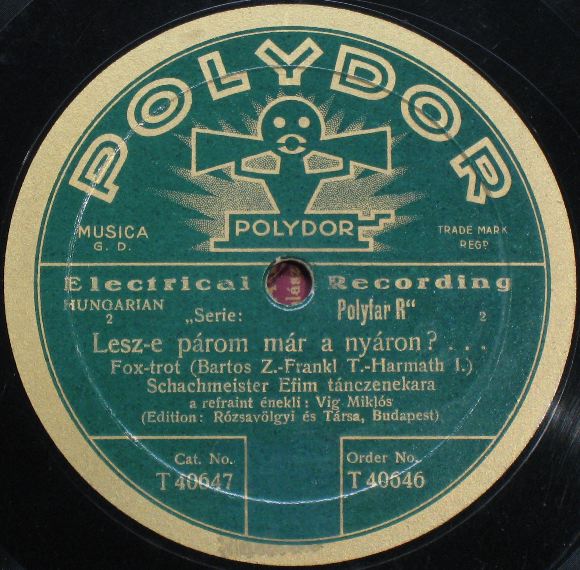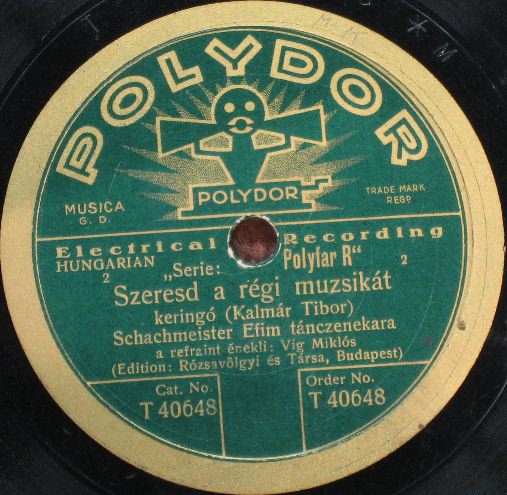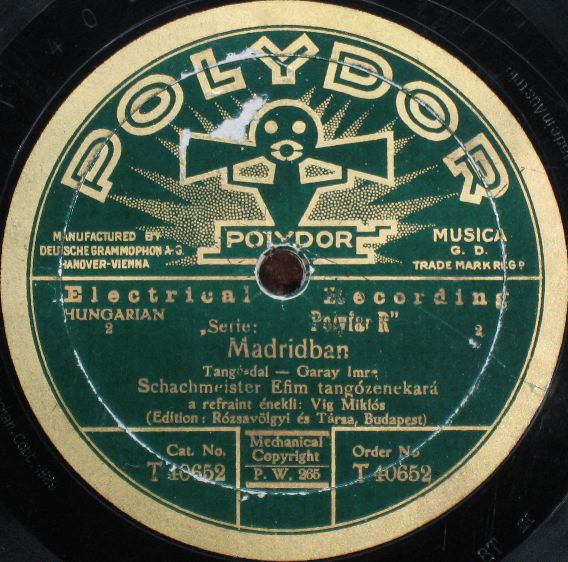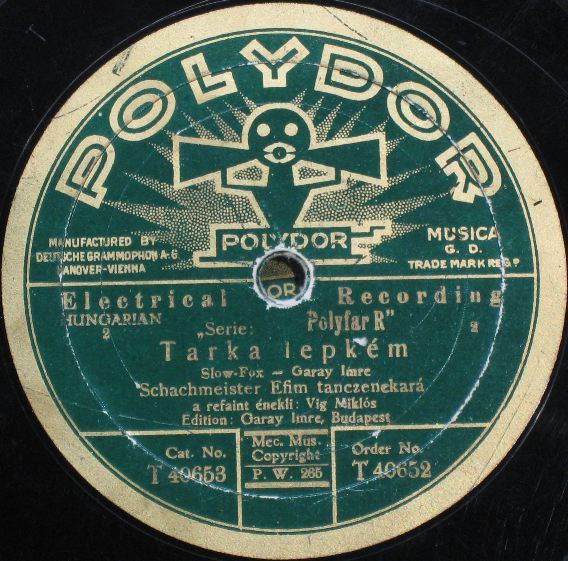Digitising 78rpm Records
Vintage Blog from 27-Apr-2013
DJing and Mixing 1920s technology with the state of the art...
To cut to the chase, if you want to just hear the music you can listen to the entire converted discography on the Miklós Vig Wikipedia page.
A recent Googling exercise in conjunction with some genealogical research on my ancestors turned up some rare recordings of my great uncle Miklós Vig [wikipedia.org] on Vatera, a Hungarian eBay-style online marketplace.
Thanks to my amazing second cousin Gabi, who still lives in Hungary, and the almost bizarre coincidence of her officemate Laszlo coming to Sydney on business, I had the records in my hands only a fortnight later.
Once I had these precious 1920s recordings in my posession, I needed to find a way to actually listen to them. I then embarked on a bit of an armchair oddysey to figure out the best way to unlock these sounds that were recorded nearly 80 years ago.
This page describes the equipment and process that I used and also contains some actual examples of the recorded sound. Hopefully this will be of help to others out there who are interested in resurrecting old recordings. I am not a hard-core "audiophile" who needs to run everything on an amp that uses vacuum tubes made from glass that was hand-blown by naked virgins from a particular little village in Yorkshire... but on the other hand, I didn't think I would be happy with the quality of the cheap USB Turntables that seem to be cropping up. Basically, my quest was to see what I could do with a reasonably generous budget.
While I am extremely pleased with the outcome, I do not particularly endorse any of the companies listed below - do your own research to be sure you get the best products. Please note that I do not take any responsibility for damage that you may cause to your records as a result of these instructions. Also, it's important for you to check your local laws about the legality of copying old records. Since I live in Australia, I used The Australian Copyright Council as a guide. According to their site, since these works were published in 1929 they are now out of copyright.
Objectives:
- Digitise the sounds on 78rpm shellac records
- Enhance the sounds to overcome some of the limitations of the 1929 technology
- Use free/open-source software where possible
- Spend < AU$1000
Background:
There is a great Wikipedia article on The Gramophone Record which explains the history of the medium and also points out the differences between 78rpm shellac recordings and the more "modern" vinyl records. The shellac records are extremely brittle and while my records are in remarkably good condition, some of them have some chipping on the edges (fortunately outside the playing area).
Cleaning:
Shellac records are extremely fragile and due to their age will invariably be coated in years of dirt. Playing a record inherently involves dragging a stylus across the entire surface and therefore I wanted to clean the records thoroughly to avoid inducing any further damage. Shellac records need special attention when cleaning because they are incompatible with many of the cleaning products used on vinyl records (for example, you cannot use alcohol-based cleaners). I used Miracle Record Cleaner made by Disc Doctor along with their Disc Doctor Cleaning Brush A. This stuff is really expensive, but was very effective in making the records visibly much cleaner. I got this stuff at Decibel Hi Fi who were informative and shipped next-day. Be careful not to get the label at the centre of the record wet. The hardest part is to fight the urge to play the records immediately after cleaning them since they require some time to dry.
Equipment - Player:
Although there is plenty of software out there that will let you play a record at 33rpm and then digitally convert the sound to 78rpm, I wanted to get a record player that could natively do 78rpm. Also, because of my budget, I wanted to get a player that had a digital output so I wouldn't need a seperate pre-amp and A/D converter. I looked on eBay, but then decided that for such delicate equipment, I didn't want to rely on a sight-unseen purchase. The local HiFi shops didn't have players that would do 78rpm, have a digital output and were in my price bracket so I went to have a look at some DJ shops. Lo and behold, there is a whole world out there of DJ shops with all sorts of cool equipment - including many options that met the above criteria. I decided to get the Stanton ST.150 from a local shop called DJ Warehouse. In addition to the above features, it also had an easy to use pitch adjust and key lock feature which let you do some of the processing on the player (and means you can hook it up to the stereo and play it live with certain digital adjustments). It also has an easily removable cartridge headshell... see below for why this is a good feature. While I was in the shop, I also picked up some stylus cleaner and a carbon fibre anti-static record brush. These were sold at the DJ shop and were from a company called AM Denmark A/S. The guys at the store seemed quite knowledgable on the equipment - but a bit less so in regards to playing 78rpm records. Also, I was able to bargain them down to a price significantly below the price on their web site.
Equipment - Stylus:
Old 78rpm records have wider grooves than 33 and 45rpm records and therefore need a special stylus designed for the wider groove. You can theoretically use a stylus designed for the smaller grooves of a 33 or 45, but you will lose out on sound quality as the thinner stylus bounces around the groove. You may also further deteriorate the old record. I decided to use the Shure M78S phono cartridge which is specifically designed for the wider grooves. I mounted this stylus on an extra Stanton headshell (bought seperately) which would allow me to easily and quickly switch between the 78rpm stylus and the 33/45rpm sytlus (after all this effort, I might as well convert my 33rpm vinyl as well).
Equipment - Other:
My Mac has fibre optic digital audio inputs (S/PDIF) while the Stanton ST.150 has coaxial digital outputs (S/PDIF). I was able to find the necessary converter at Jaycar (a local electronics shop) for AU$59.95.
Equipment - Setup:
Record players are far from "plug and play" like their modern CD and DVD player cousins. Certain adjustments need to be made to regulate the stylus pressure as well as the "anti-skating" force and even the tonearm height. Unfortunately, the instructions that came with my player were far from clear. After doing some Googling, I settled on a stylus pressure of 2.5g, an anti-skating pressure of 0.0g and a tonearm height of 4. These settings worked great for me - but you should follow the instructions in your manual and do your own research as well.
Software:
Having spent a small fortune on equipment, accessories and cleaning products, I began to look at open source / freeware software to do the conversion. My intention was to store and archive the high sampling rate digital output so that in the future when the software inevitably improved, I would have a basic digital "snapshot" of the records. I would then use whatever software was available today to clean up the sound and convert it to a compressed format for easy listening on arbitrary portable devices. I preferably wanted software that would run natively on a Mac, but it turns out that most of the software I used also has Linux and Windows versions. To cut to the chase, I used the following software:
- Audacity - Record and manipulate the sound (Open Source, Multi-Platform)
- Metronome - Estimate tempo (Freeware, OS X)
- Mixxx - Change pitch and speed in real time (Open Source, Multi-Platform)
- LAME - Convert files to MP3 (Open Source, Multi-Platform)
Equalisation:
Modern records all apply something called the RIAA equalization curve to allow a uniform compression of the soundwave for better recording on the narrow tracks of a record. By "modern" I mean anything after the late-1940's. The Audacity documentation also has a good explanation of this. Modern equipment all assumes the media has these curves built in and therefore has equalizers to compensate. This is part of the phono stage in component systems and will almost certainly be built into your turntable. My 78's didn't use the RIAA equalization curve - typically 78's used none at all, or a different one for each label! Audacity can reverse the unneeded RIAA equalization from the turntable, and get back the correct sound. You may want to do two passes; one to remove RIAA and then another to apply the correct EQ for the relevant label. The bottom of this page has the settings for the 78s from various labels. There is also some further explanation here.
The First Playing:
After cleaning and drying the records, I was ready for the first play. It was quite an experience to hear the brittle old records come to life. These were pressed in Austria in 1929 and, unlike my great uncle, had survived World War II as well as the subsequent turmoil of the 20th century.
The following is the completely unmodified (except for MP3 compression to ease the load on my server) first playing of Lesz-e párom már a nyáron? sung by my great uncle Miklós Vig.
Click on the record label to play the track.
Restoring the Sound:
Once I recorded all of the records, I began playing with Audacity and ClickRepair to remove the clicks, pops and hiss and also to liven up the music a bit. I also used the Metronome program to determine the BPM (Beats Per Minute) of the music. Since I knew what type of music this was (Foxtrot, Tango, etc.) I knew roughly what the correct speed was supposed to be (e.g. Tango = 128bpm). Because 78rpm records are actually a misnomer (a universal standard speed did not exist in those days) I used the metronome and Mixxx to play with the speed. Finally I used LAME as a plug-in to Audacity to export the files as MP3s.
Below are the cleaned up recordings compressed into MP3 files. (Click on the relevant record label)
As of this writing I am still continuing to play with the software to further improve the sound. I have saved uncompressed WAV format files of the raw digital recordings straight out of the record player for future generations. I hope to use these uncompressed archival files in conjunction with much more powerful software that undoubtedly will come out in the future. I also plan to convert the WAV format files to whatever new file standards come out so that these recording can survive another 80 years of technical progress (and hopefully less global turmoil).
And what about all the equipment I bought? Well, with my new found interest in "old sound" I have discovered a local record shop (and I mean "record shop" not "music store") that has tons of older music that doesn't exist on CD today. There is plenty more music out there to convert...
Reference:
- Lesz-e párom már a nyáron?, Foxtrot, Composed by Efim Schachmeister, Sung by Miklós Vig, Lyrics by Z. Bartos, T. Frankl, I. Harmath, Produced by Rózsavölgyi and Társa, Budapest, 1929.
- Szeresd a régi muzsikát, Keringó, Composed by Efim Schachmeister, Sung by Miklós Vig, Lyrics by Tibor Kalmár, Produced by Rózsavölgyi and Társa, Budapest, 1929.
- Madridban, Tango, Composed by Efim Schachmeister, Sung by Miklós Vig, Lyrics by Imre Garay, Produced by Rózsavölgyi and Társa, Budapest, 1929.
- Tarka lepkém, Slow Fox, Composed by Efim Schachmeister, Sung by Miklós Vig, Lyrics by Imre Garay, Produced by Rózsavölgyi and Társa, Budapest, 1929.
Version 1.1, 27-April-2013



